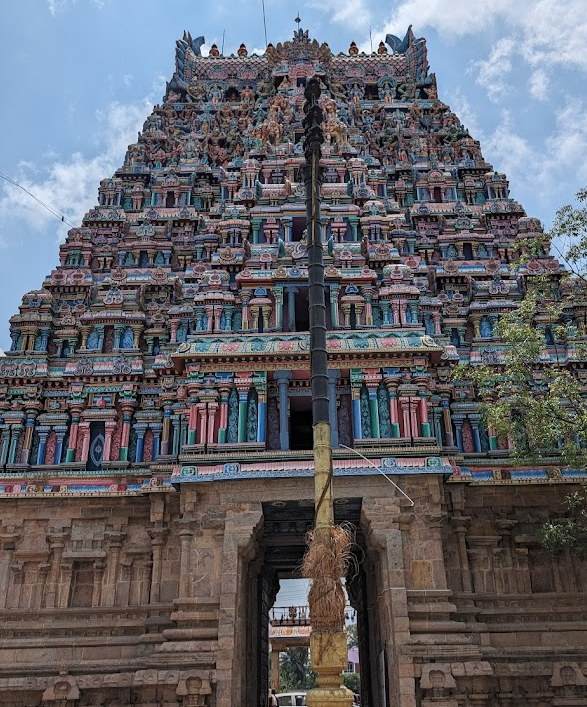According to the scriptures, during the great deluge (Pralaya), Lord Brahma took the soil from this sacred place, fashioned it into a pot, and used it to safeguard the Vedas.
Mother Cauvery, seeking to be honoured with the status of the Holy Ganga, which is revered for washing away the sins of those who bathe in its waters, performed penance under the Bodhi tree on the western bank of the Sara Pushkarini. Pleased with her devotion, Lord Vishnu appeared as a small child and crawled onto Cauvery’s lap.
Cauvery, however, desired more than just this boon. She requested that Lord Vishnu remain in this place in His divine form along with His five consorts. In response, Lord Vishnu granted her request, appearing with His consorts. He also made a space for Cauvery in the Sanctum Sanctorum, to His left, which devotees can still see today.
Sthala Purana :
The Saranathan Temple, located in Thirucherai, a village near Kumbakonam in Tamil Nadu, is dedicated to Lord Vishnu, who is worshipped here as Saranathan, with his consort Lakshmi as Saranayaki. This temple is celebrated in the Divya Prabandha, the early medieval Tamil canon of the Azhwar saints from the 6th–9th centuries AD, and is one of the 108 Divya Desams dedicated to Vishnu.
This is the only temple where Lord Perumal blesses devotees alongside his five consorts—Sridevi, Bhoodevi, Mahalakshmi, Saranayaki, and Neeladevi. The name "Saranathan" comes from the fertile nature of the soil here, known as "Saram," and the place name, Tiru Charam, later evolved into Tirucherai.
According to legend, during the Pralaya (the great deluge), Lord Brahma took soil from this place, crafted a pot, and placed the Vedas in it for safekeeping. River goddess Cauvery performed penance under the Bodhi tree on the western bank of Sara Pushkarini, seeking a status equal to that of the Holy Ganga, known for washing away sins.
Pleased with her devotion, Lord Perumal appeared as a child on Cauvery's lap. When Cauvery requested that He remain in that form, Perumal, along with his five consorts, granted her wish and also granted her a place in the sanctum sanctorum to his left, which is still visible to devotees.
Another legend speaks of King Azhagia Manavala Naicken, who sent stones for the renovation of the Mannargudi Sri Rajagopalaswamy temple. The carts carrying these stones passed through Thirucherai, and a devotee named Narasabhupalan took one stone from each cart for the renovation of the Saranathan Temple. When the king discovered this, he came to investigate. However, Perumal appeared before the king as Lord Rajagopalaswami, and the king, moved by the divine vision, ordered renovations for the Saranathan Temple as well.
Devotees believe that praying at this temple can absolve them of sins, offering benefits equivalent to 100 baths in the River Cauvery. Lord Saranathan grants darshan in a standing posture facing east. The temple also has shrines dedicated to Sage Agastya, Lord Brahma, and Mother Cauvery on the western bank of Sara Pushkarini, opposite the main temple.
Legends :
Devotees believe that bathing in the Sara Pushkarani and worshipping Sri Saranathan at this temple absolves them of sins. After their wishes are fulfilled, they offer Thirumanjanam (a ritual bath) and new garments to the deity. It is said that worshipping Sri Saranathan here is equivalent to bathing in the River Kaveri a hundred times.
Another legend tells that Vyazhan (Jupiter) gave darshan to River Kaveri on the 10th day of the Thaipusam festival during the chariot procession. Devotees believe that bathing in the Sara Pushkarani on the Poosam nakshatra day in the month of Thai is as auspicious as participating in the Mahamaham festival, which occurs once every 12 years.
In another tale, River Kaveri performed penance under a peepal tree on the western bank of Sara Pushkarani, seeking a status equal to that of the Ganga. Lord Vishnu first appeared as a child on her lap, but Kaveri insisted on her request. Vishnu then appeared with His five consorts on Garuda, granting her wish. Satisfied, Kaveri requested Vishnu to remain in the temple with His consorts, and thus, He resides as Saranathan with His five consorts in the sanctum sanctorum.
In a different legend, a Nayaka king sent stones through this region for the construction of the Mannargudi Rajagopalan temple. Unbeknownst to the king, Narasaboobalan, the person in charge of transporting the stones, took one stone from each vehicle for the construction of this temple. When the king discovered this, he visited the temple. Narasaboobalan, fearing the king's wrath, prayed to Sri Saranathan for protection. When the king arrived, he was astonished to see Saranathan appearing as Mannargudi Rajagopalan and, pleased with the sight, pardoned Narasaboobalan.
